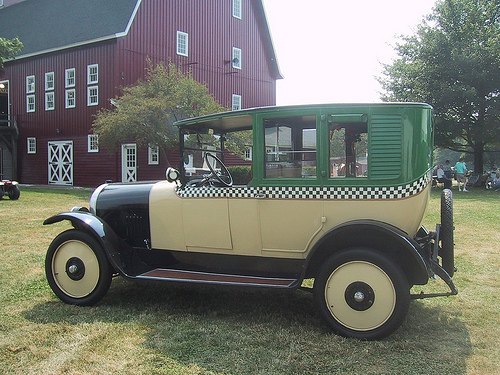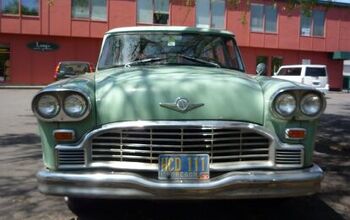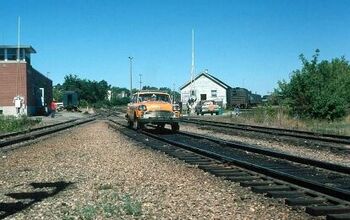An Illustrated History Of Checker Motors

[Note: Three related Checker posts: 1967 Marathon Curbside Classic; Vintage Checker Ads; and Tomorrow’s Checker? Also note that these pictures were found at a variety of sites, but it appears that the original source for most of them were posted on this Flickr account by Drivermatic. Thanks for the superb photographic resource!]
For sixty years, Checker Motors had a record unbroken run of profits building a few thousand cars per year in a small little factory in Kalamazoo, Michigan. In 1981, it posted its first loss, $488,326, and its owner made good on his threat to stop production of the iconic Marathon if his workers didn’t accept wage concessions. But Checker continued to stamp out body parts for GM into 2009, including for the Buick LaCrosse. The Carpacolypse of 2009 finally shuttered the ancient plant, but no need to shed a tear for the original owner’s son, David Markin: his wealth is estimated at over $100 million. And it was all due to a shrewd investment of $15,000 that his father made in 1920, which put him in the driver’s seat of Checker Motors. Let’s take a ride through Checker’s history. Taxi!
To understand the origins of Checker, one has to know that the taxi business was once very different than now: two or more companies competed fiercely in each city for the growing and lucrative business in those days. If you want the remarkable details of shady deals, graft and stock manipulation that created the two largest cab companies, Yellow and Checker, head over to coachbuilt.com‘s very detailed history. A slightly less detailed but also excellent Checker history is also at checkertaxistand.com. Lets just say the upshot was that Checker Cabs wanted a custom built taxi, and somehow the son of a poor Russian tailor, Morris Markin, cleverly managed to manipulate himself (and some stock holdings he managed to get revalued) in the position to provide it, the first Checker Model C of 1922.
It’s important to remember that in the twenties, there were dozens of small car manufacturers, so in its early days, Checker’s scale wasn’t at all unusual. And the factory instantly became a profitable enterprise. And Markin expanded his holdings with Checker stock and profits including some large taxi operating companies and in later years truck trailer building (Great Dane) and other businesses.
During this period, taxis competed on prestige, size and comfort, as most working folks stuck to taking the streetcar or bus. The Checkers from the late twenties were large handsome cars, and as in the old coach-built tradition, often had a rear roof section that could be lowered in nice weather, as much as to be seen as to see.
Checker styling started becoming a bit adventurous in the thirties, but the the full degree of that was still a few years off.
As always, Checkers were designed specifically for the job, both in their layout and rugged construction.
The all-new 1939 Model A feature a highly bizarre front end whose only redeeming feature was that it was recognizable from half a mile away. The debate who designed it is still unresolved, but actually, from the front end back, it was a quite a conservatively styled sedan with a highly unusual feature.
It had a remarkably advanced (and patented) optional steel rear laundalet roof section that could be lowered as seen here.
Rather unusual for such a small company, Checker ambitiously explored advanced designs during the forties, including this one-off rear-engined prototype. Looking all the world like a giant Fiat 600 Multipla, it was probably for the best that it was not developed further.
But a FWD prototype, with the straight six in a transverse arrangement was built and seriously considered. This is the first I’ve seen or heard about this, and its quite a remarkably advanced design for the times, looking much more French than Kalamazoo. Technical difficulties with the FWD transaxle killed it, probably for the best in terms of preserving the Checker reliability reputation.
The conventional new A6 of 1946 had traditional styling, and with minor retouches, was the iconic cab of the post war era.
Like the legendary later Aerobus, Checker was building extended wheelbase vehicles in the forties, like this six door, twelve passenger wagon. These were the shuttle buses of their day.
In 1955, an all new Checker was developed in their advanced styling sudios (a corner of the factory partitioned off with drapes). The new A8 was designed to meet Manhattan’s new taxi regulations, and featured independent suspension on the front for the first time. Not that it made the Checker famous for its ride, however. The suspension engineering department lived in the janitor’s closet.
Interior space was always the highlight of the Checkers, and the Marathon’s tall roof, totally flat floor and two folding jump seats meant that up to five patrons could be accommodated in the rear compartment alone. Guess who got the jump seats? The pretty young lady. Beats sitting in the guys’ laps, anyway.
There’s a treasure trove (143) of vintage Checker photos that have been posted at this Flickr account, the source of many of the pictures here, including an extensive tour of the Checker factory led by this charming and knowledgeable woman, who here is pointing out the finer details of Checker’s legendary frame, the source of its ruggedness and flat floor.
The six and eight-door Aerobuses were the stuff of legends in their day. Unlike today’s stretch limos with their cut and welded frame extensions, these long boys sat on a completely unique and specially designed frame, and enjoyed a high degree of structural integrity.
Not surprisingly, the rugged Checker frame lent itself well to custom coachbuilding, like this Swiss ambulance. It was the Checker’s taxi cab image that probably kept it from more success in the US as a limo and hearse source. If folks couldn’t afford a Cadillac while they were still alive, they at least wanted to ride to their graves in one.
Checker also made an extended body sedan, and pushed it as a limo alternative, including versions with padded roofs and even an opera window. But time was moving on, and the garish seventies made the Checkers look like stale bread.
Checker Motors operated most profitably with an annual production of 6-8k cars, but after 1970 that became increasingly difficult, due to major markets like NYC loosening their taxi regulations to allow conventional sedans to operate. They were obviously cheaper for the Big Three to build, and the fleet dumping practices of the seventies was Checker’s coffin nail as a producer of cars. In 1981, Checker had its only posted loss after some sixty years, having survived the Depression profitably, if on a smaller scale.
Former GM President Ed Cole bought 50% of Checker for $6 million and began plans to build a completely new car for a new era. His first prototypes were based on lengthened VW Rabbits, but his death at the controls of his personal airplane ended that. But some work continued based on his ideas, and utilizing GM’s X-Body (Citation) FWD drivetrain and a solid rubber rear suspension spring. Checker founder’s son David Markin was more interested in tennis than new adventures, and it all came to naught.
But Checker continued to build parts until 2009, when the downturn finally swamped them too. The little factory that hummed away for almost ninety years has been razed, leaving just the footings to mark where one of the more unusual automotive stories played out.

More by Paul Niedermeyer
Latest Car Reviews
Read moreLatest Product Reviews
Read moreRecent Comments
- Kmars2009 I rented one last fall while visiting Ohio. Not a bad car...but not a great car either. I think it needs a new version. But CUVs are King... unfortunately!
- Ajla Remember when Cadillac introduced an entirely new V8 and proceeded to install it in only 800 cars before cancelling everything?
- Bouzouki Cadillac (aka GM!!) made so many mistakes over the past 40 years, right up to today, one could make a MBA course of it. Others have alluded to them, there is not enough room for me to recite them in a flowing, cohesive manner.Cadillac today is literally a tarted-up Chevrolet. They are nice cars, and the "aura" of the Cadillac name still works on several (mostly female) consumers who are not car enthusiasts.The CT4 and CT5 offer superlative ride and handling, and even performance--but, it is wrapped in sheet metal that (at least I think) looks awful, with (still) sub-par interiors. They are niche cars. They are the last gasp of the Alpha platform--which I have been told by people close to it, was meant to be a Pontiac "BMW 3-series". The bankruptcy killed Pontiac, but the Alpha had been mostly engineered, so it was "Cadillac-ized" with the new "edgy" CTS styling.Most Cadillacs sold are crossovers. The most profitable "Cadillac" is the Escalade (note that GM never jack up the name on THAT!).The question posed here is rather irrelevant. NO ONE has "a blank check", because GM (any company or corporation) does not have bottomless resources.Better styling, and superlative "performance" (by that, I mean being among the best in noise, harshness, handling, performance, reliablity, quality) would cost a lot of money.Post-bankruptcy GM actually tried. No one here mentioned GM's effort to do just that: the "Omega" platform, aka CT6.The (horribly misnamed) CT6 was actually a credible Mercedes/Lexus competitor. I'm sure it cost GM a fortune to develop (the platform was unique, not shared with any other car. The top-of-the-line ORIGINAL Blackwing V8 was also unique, expensive, and ultimately...very few were sold. All of this is a LOT of money).I used to know the sales numbers, and my sense was the CT6 sold about HALF the units GM projected. More importantly, it sold about half to two thirds the volume of the S-Class (which cost a lot more in 201x)Many of your fixed cost are predicated on volume. One way to improve your business case (if the right people want to get the Green Light) is to inflate your projected volumes. This lowers the unit cost for seats, mufflers, control arms, etc, and makes the vehicle more profitable--on paper.Suppliers tool up to make the number of parts the carmaker projects. However, if the volume is less than expected, the automaker has to make up the difference.So, unfortunately, not only was the CT6 an expensive car to build, but Cadillac's weak "brand equity" limited how much GM could charge (and these were still pricey cars in 2016-18, a "base" car was ).Other than the name, the "Omega" could have marked the starting point for Cadillac to once again be the standard of the world. Other than the awful name (Fleetwood, Elegante, Paramount, even ParAMOUR would be better), and offering the basest car with a FOUR cylinder turbo on the base car (incredibly moronic!), it was very good car and a CREDIBLE Mercedes S-Class/Lexus LS400 alternative. While I cannot know if the novel aluminum body was worth the cost (very expensive and complex to build), the bragging rights were legit--a LARGE car that was lighter, but had good body rigidity. No surprise, the interior was not the best, but the gap with the big boys was as close as GM has done in the luxury sphere.Mary Barra decided that profits today and tomorrow were more important than gambling on profits in 2025 and later. Having sunk a TON of money, and even done a mid-cycle enhancement, complete with the new Blackwing engine (which copied BMW with the twin turbos nestled in the "V"!), in fall 2018 GM announced it was discontinuing the car, and closing the assembly plant it was built in. (And so you know, building different platforms on the same line is very challenging and considerably less efficient in terms of capital and labor costs than the same platform, or better yet, the same model).So now, GM is anticipating that, as the car market "goes electric" (if you can call it that--more like the Federal Government and EU and even China PUSHING electric cars), they can make electric Cadillacs that are "prestige". The Cadillac Celestique is the opening salvo--$340,000. We will see how it works out.
- Lynn Joiner Lynn JoinerJust put 2,000 miles on a Chevy Malibu rental from Budget, touring around AZ, UT, CO for a month. Ran fine, no problems at all, little 1.7L 4-cylinder just sipped fuel, and the trunk held our large suitcases easily. Yeah, I hated looking up at all the huge FWD trucks blowing by, but the Malibu easily kept up on the 80 mph Interstate in Utah. I expect a new one would be about a third the cost of the big guys. It won't tow your horse trailer, but it'll get you to the store. Why kill it?
- Lynn Joiner Just put 2,000 miles on a Chevy Malibu rental from Budget, touring around AZ, UT, CO for a month. Ran fine, no problems at all, little 1.7L 4-cylinder just sipped fuel, and the trunk held our large suitcases easily. Yeah, I hated looking up at all the huge FWD trucks blowing by, but the Malibu easily kept up on the 80 mph Interstate in Utah. I expect a new one would be about a third the cost of the big guys. It won't tow your horse trailer, but it'll get you to the store. Why kill it?




















































Comments
Join the conversation
I like the 1939 model A cab and so do a lot of fellow model train buffs who have made scale models of NYC in 1/48 scale with trolleys and elevated trains along with the models of the 3 rd Ave trolleys and buses these types of taxis would be the perfect thing, would there be any way 1/48 scale models be made of these model A taxis ? not just for model train builders but also for model car collectors as this was a unique taxi.
The only thing left today is the test track.